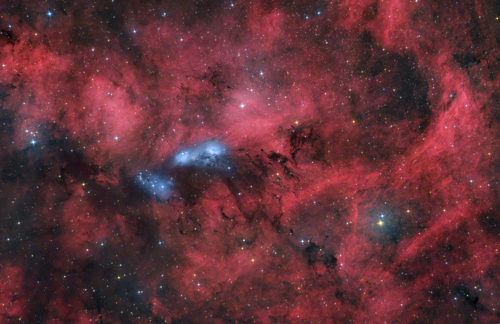This picture was taken in Saint-May, Drôme Provençale, France, more precisely in the Parc Naturel Régional des Baronnies Provençales, wich is currently under the process to become a RICE ( International Dark Sky Reserve with IDA Dark Sky Association)
My picture can be credited if shared with this instagram account : Instagram.com/martinlefrancphotographie
Here is more about the picture :
The nocturnal magic of Saint-May, in the Drôme
This is nother image made as part of my night tour of the Baronnies Provençales. Again I was granted with some amazing airglow, there is more and more of this green airglow visible in this region, and sometimes in fascinating manners like here where it was arching across all southern horizon. Maybe this is due to the fact that more and more villages like Saint-May are turning their lights off at night.
This is a panorama covering 180°, which gives this "3D" aspect, a little distorted of the foreground. But it allows you to admire the celestial vault in a wide field!
It was taken in the heart of the picturesque village, with its narrow streets typical of the perched villages of the Drôme Provençale. The village lies between a steep rocky outcrop and the Caire rock above Remuzat. It overlooks the Eygues valley. Minimum altitude: 382m. Maximum altitude: 1173m! In the background, you can admire the Saint-Laurent plateau, majestic under a starry sky.
In the sky, the arch of the Milky Way stretches magnificently over the village, illuminating the landscape with its celestial glow.
There's also an impressive airglow, those subtle natural light waves created by chemical reactions in the upper atmosphere, adding a touch of mystery and beauty to the scene.
In St May, street lighting is turned off in the evening, allowing the stars to shine in all their splendor and offering an incomparable night sky-watching experience. The low population density of the surrounding area, and the policy of switching off street lighting throughout the Baronnies Natural Regional Park, makes for one of the best night-time experiences in France!
EXIF
Nikon D7500 & sigma18-35 f/1.8
Panorama of 35 images, 13 seconds iso 8000
18mm f/1.8
Stitched together in AutopanoGiga and contrast and saturation added in Photoshop.
Mention :
ABSOLUTELY NO USE OF AI WAS DONE TO TAKE OR EDIT THIS PICTURE, NO NOISE REDUCTION, NO CONTENT FILLING, NOTHING WAS SUPPRESSED OR ADDED.
 The nocturnal magic of St-May
The nocturnal magic of St-May by
Martin Lefranc, sur Flickr


 NGC 6888 - "Crescent Nebula" by Harley Grady, on Flickr
NGC 6888 - "Crescent Nebula" by Harley Grady, on Flickr
 The nocturnal magic of St-May by Martin Lefranc, sur Flickr
The nocturnal magic of St-May by Martin Lefranc, sur Flickr Villarrica volcano and southern cross by Marcelo Maturana, en Flickr
Villarrica volcano and southern cross by Marcelo Maturana, en Flickr

 M51 LRVB by David Duarte, sur Flickr
M51 LRVB by David Duarte, sur Flickr